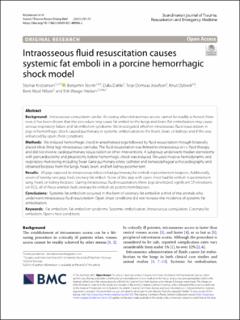| dc.contributor.author | Kristiansen, Steinar | |
| dc.contributor.author | Storm, Benjamin | |
| dc.contributor.author | Dahle, Dalia | |
| dc.contributor.author | Josefsen, Terje D. | |
| dc.contributor.author | Dybwik, Knut Gustav | |
| dc.contributor.author | Nilsen, Bent Aksel | |
| dc.contributor.author | Nielsen, Erik Waage | |
| dc.date.accessioned | 2022-02-11T14:20:40Z | |
| dc.date.available | 2022-02-11T14:20:40Z | |
| dc.date.created | 2022-01-02T15:06:24Z | |
| dc.date.issued | 2021 | |
| dc.identifier.citation | Kristiansen, S., Storm, B., Dahle, D., Josefsen, T. D., Dybwik, K., Nilsen, B. A. & Waage-Nielsen, E. (2021). Intraosseous fluid resuscitation causes systemic fat emboli in a porcine hemorrhagic shock model. Scandinavian Journal of Trauma, Resuscitation and Emergency Medicine, 29: 172. doi: | en_US |
| dc.identifier.issn | 1757-7241 | |
| dc.identifier.uri | https://hdl.handle.net/11250/2978535 | |
| dc.description.abstract | Background Intraosseous cannulation can be life-saving when intravenous access cannot be readily achieved. However, it has been shown that the procedure may cause fat emboli to the lungs and brain. Fat embolization may cause serious respiratory failure and fat embolism syndrome. We investigated whether intraosseous fluid resuscitation in pigs in hemorrhagic shock caused pulmonary or systemic embolization to the heart, brain, or kidneys and if this was enhanced by open chest conditions. Methods We induced hemorrhagic shock in anesthetized pigs followed by fluid-resuscitation through bilaterally placed tibial (hind leg) intraosseous cannulas. The fluid-resuscitation was limited to intraosseous or i.v. fluid therapy, and did not involve cardiopulmonary resuscitation or other interventions. A subgroup underwent median sternotomy with pericardiectomy and pleurotomy before hemorrhagic shock was induced. We used invasive hemodynamic and respiratory monitoring including Swan Ganz pulmonary artery catheter and transesophageal echocardiography and obtained biopsies from the lungs, heart, brain, and left kidney postmortem. Results All pigs exposed to intraosseous infusion had pulmonary fat emboli in postmortem biopsies. Additionally, seven of twenty-one pigs had coronary fat emboli. None of the pigs with open chest had fat emboli in postmortem lung, heart, or kidney biopsies. During intraosseous fluid-resuscitation, three pigs developed significant ST-elevations on ECG; all of these animals had coronary fat emboli on postmortem biopsies. Conclusions Systemic fat embolism occurred in the form of coronary fat emboli in a third of the animals who underwent intraosseous fluid resuscitation. Open chest conditions did not increase the incidence of systemic fat embolization. | en_US |
| dc.language.iso | eng | en_US |
| dc.publisher | BioMed Central | en_US |
| dc.rights | Navngivelse 4.0 Internasjonal | * |
| dc.rights.uri | http://creativecommons.org/licenses/by/4.0/deed.no | * |
| dc.title | Intraosseous fluid resuscitation causes systemic fat emboli in a porcine hemorrhagic shock model | en_US |
| dc.type | Peer reviewed | en_US |
| dc.type | Journal article | en_US |
| dc.description.version | publishedVersion | en_US |
| dc.rights.holder | © 2021 The Author(s) | en_US |
| dc.subject.nsi | VDP::Medisinske Fag: 700::Basale medisinske, odontologiske og veterinærmedisinske fag: 710::Patofysiologi: 721 | en_US |
| dc.subject.nsi | VDP::Medisinske Fag: 700::Klinisk medisinske fag: 750::Lungesykdommer: 777 | en_US |
| dc.source.pagenumber | 8 | en_US |
| dc.source.volume | 29 | en_US |
| dc.source.journal | Scandinavian Journal of Trauma, Resuscitation and Emergency Medicine | en_US |
| dc.identifier.doi | 10.1186/s13049-021-00986-z | |
| dc.identifier.cristin | 1973357 | |
| dc.source.articlenumber | 172 | en_US |

